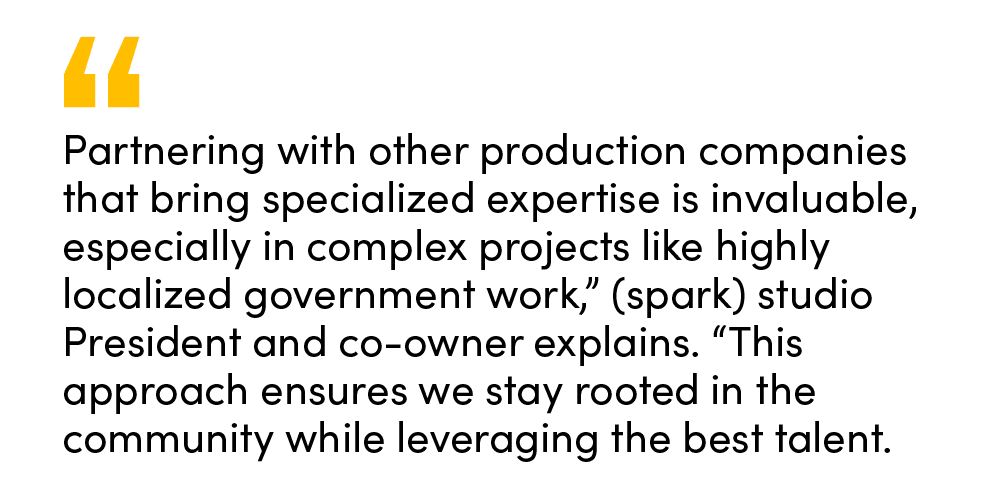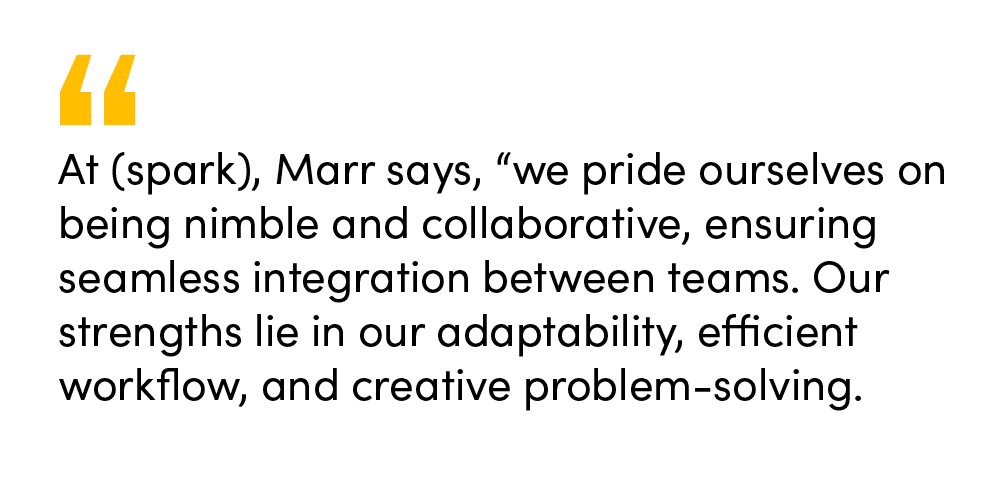Any video production is inherently a collaborative effort, involving coordination and communication among any number of individuals, including the director, producer, camera operator, on-screen talent, lighting and audio technicians, gaffers, stylists, and potentially many others. And that’s just on the set! Pre- and post-production involve even more roles, from location and talent scouts; wardrobe, set, and props design; video editors, audio mixers, color grade specialists, motion graphics artists, and more. In short, even the simplest video production requires a significant number of people working together to deliver the final product to the client.
So, given the naturally collaborative nature of video production, why aren’t more production studios partnering with each other to tackle bigger projects and clients? Increasingly, the answer is that they are! And it’s little surprise: video is the fastest-growing type of digital advertising, with global viewers collectively watching more than 1 billion hours of video content every day on YouTube alone! That doesn’t even account for all the video content that appears on TikTok, Instagram, Facebook, and the websites of individual brands. To keep up with the demand for video content, more and more agencies and studios are joining forces to produce more content, on a bigger scale, with more efficiency and expertise than ever before. Read on to discover different types of partnerships, their benefits, and some of (spark) studio’s best practices for building and working with your own partnerships.
Video Production Partnerships 101
Simply put, a video production agency partnership is any agreement between two or more agencies or studios to strategically collaborate on a project where their specialties or services can complement each other. “Partnering with other production companies that bring specialized expertise is invaluable, especially in complex projects like highly localized government work,” (spark) studio President and co-owner Ember Marr explains. “This approach ensures we stay rooted in the community while leveraging the best talent.”

For instance, a studio with top-level directors might partner with a high-end special effects studio to help achieve a realistic explosion scene in the Super Bowl commercial they’ve been hired to produce. Or, more commonly, a creative content agency in a big city might hire a local production and scouting team in a smaller city for their on-the-ground expertise as well as their cameras and equipment. In short, every kind of partnership is going to represent a win-win for each party, helping them win new clients and deliver projects with efficiency and excellence.
“I’ve definitely seen a trend toward more partnerships between video production agencies for large projects, especially with federal contracts,” says Michael Noble, Performance Marketing Consultant at Leap Group Network. “These projects are often too big for a small agency to handle alone. Subcontracting is encouraged, and it’s common for agencies to team up to meet the requirements and deliver the full scope of work. From my experience, these partnerships have been really effective. It’s often as simple as giving the other agency a call.”

Types of collaboration among production studios
Typically, video production agency partnerships take two different forms, depending on the nature and objectives of the collaboration. The first type is an on-going partnership. This is a long-term relationship where the agency and production company or studio has a long-standing agreement to collaborate across multiple projects, or with more than one client.
This approach requires deep alignment in communication styles, creative processes, and strategic vision. When agencies find they have a good rapport, they can foster even more creative synergy and efficiency the more often they work together. Solid partnerships like this are invaluable for any agency seeking reliable collaborators eager to take on new projects and clients—protect and nurture special relationships like this, especially if you are a small or niche agency!
The other type of production agency partnership is perhaps more common: the project-based collaboration. These partnerships are, by nature, more tactical and focused on short-term objectives, such as specific campaigns that require unique skill sets (e.g., animation, VR, or complex camera work). These collaborations allow agencies to quickly respond to client needs by assembling the appropriate expertise for the project.
A recent (spark) project in Hawaii, for example, required an understanding of Hawaiian culture and relationships with native Islanders. “(spark) doesn’t have that expertise,” Noble explains, “so we partnered with a local agency with the necessary connections and knowledge. While they had the local knowledge, they lacked the bandwidth and the ability to access government contracts through sam.gov. (spark), on the other hand, have the government credentials and were able to collaborate with them to pursue the project together.”
Additionally, these one-off types of partnerships often spark creative innovation through the exchange of ideas between creative teams with different perspectives. Oftentimes, a great project-based collaboration can lead to a fulfilling long-term partnership, depending on the current market and the services each agency offers.
Benefits of video production agency partnerships
Whatever form they take, partnerships offer many advantages to everyone involved (and if they don’t, it’s time to reassess!). Here are just a few:
Access to specialized expertise—As mentioned earlier, partnerships enable smaller studios to access talent (drone operators, motion graphics specialists) and equipment (high-end cameras, large cyclorama walls) that they otherwise couldn’t afford. Plus, these specialized studios are more up to date on the latest trends and technologies related to their area, giving an even greater ROI to the partnership. “These partnerships allow us to scale out when necessary,” Marr explains. “We can bring in specific skills or resources while also maintaining the high level of craftsmanship and storytelling that (spark) studio is known for.”
Efficiency and turnaround times—When you partner with an experienced studio, you get the benefits of their established workflows that can speed up every phase of production. And, when each agency is dedicated to its specific area of the project, you get fast and focused production, edits and updates. “At (spark), Marr says, “we pride ourselves on being nimble and collaborative, ensuring seamless integration between teams. Our strengths lie in our adaptability, efficient workflow, and creative problem-solving.”
Cost-effectiveness—Again, especially for one-off projects, collaborating with a complementary studio instead of maintaining in-house specialists or investing in expensive equipment is unquestionably more cost-effective (unless you find yourself doing more and more of those types of projects). Furthermore, many agencies offer flexible packages, especially if it’s for another studio that’s going to help bring in new clients and projects.
Fresh creative perspectives—As mentioned earlier, new partners bring fresh ideas and different perspectives, allowing your studio to benefit from engaging ideation, outside innovation, and unique storytelling and production approaches without the expense of bringing on a new full-time staff member. Besides, there’s nothing like brainstorming with fellow industry experts to inject your own team with fresh energy, dynamism, and fun.

(spark) studio’s best practices for production partnerships
All that said, collaboration is not without its challenges: “Financial negotiations can be tricky,” Noble admits. “Some agencies want guaranteed payments upfront, which can be difficult because it’s hard to know the exact amount until the project is completed. As with any aspect of the partnership, this requires careful communication to ensure both parties are fairly compensated based on their contribution.”
All key parties in the partnership should come together and define clear objectives, expectations, and scope of work from the start—that includes not only compensation and billing, but also project deliverables, agency responsibilities, milestones and deadlines, creative direction and approval processes, point person with the client, and contingencies for revisions or scope changes. You’ll also want to establish intellectual property rights and ownership, stipulating which agency owns the final video, raw footage, or any stock elements. Especially if this is your first collaborative project with a particular studio, it’s better to be more specific in upfront specifications to avoid any unpleasant misunderstandings or scope creep later.
It should also go without saying (but bears repeating because it’s so important!) that you should establish and encourage open communication channels with your partner agency. If it’s a big production team, it may be helpful to identify a key point person for each agency, or for different aspects of the production if they’re significantly large or important (animal management, for example, on a video production for a national canine organization). It can also be useful to schedule regular check-ins to keep everyone on the same page and use web-based project management tools that are easy for everyone to access.

Finally, remember to foster a culture of collaboration rather than micromanagement: if one team is consistently overruled in its effort to make the production the best it can be, you’re missing out on one of the key benefits of collaborating. (After all, you chose to partner together because you valued each other’s expertise, right?) Encourage feedback early and often so that everyone feels comfortable voicing concerns and you avoid major issues (and costly reworks) further down the road.
“My biggest piece of advice to studios considering embarking on a partnership is to identify mutual problems and solutions,” Noble says. “Where do you need help, and how can your partner solve that? And where can you help them? It’s important to be transparent, especially when it comes to budgets. Have open communication and use NDAs to protect sensitive information.”